
Marrakech
Marrakech — Toilets of Morocco
VisitingMarrakech
Marrakech
was the third of three imperial cities
I visited in Morocco,
places where the Sultan lived.
Meknès and Fez were the other two.
As in Fez,
Marrakech has an elaborately decorated madrasa
or religious school with fountains used for
mîdhâ or ablutions,
pre-prayer washing.
The only significant structure left from the Almoravid dynasty
is an ablutions complex near that madrasa and what was,
at the time, the city's primary mosque.
The Mouassine hammam or public bath and the associated
fountains are another significant plumbing-related
sight in the medina, the walled old city.
Riad Zitoun Lakdim
Moroccan Train ToiletsI traveled from Tangier to Marrakech on the overnight train, comfortably resting in a couchette bunk. See the Moroccan train toilets page for details on the on-board plumbing.
Guesthouses at Booking.comOnce we arrived the next morning in Marrakech, I took a petit taxi to the edge of the medina and found my lodging in the usual fortress-like riad structure on one of the many narrow lanes. I stayed at Riad Zitoun Lakdim the first time I was in Marrakech, a little over half-way into my trip. A room with a shared bath was 130 Dirham or about US$ 12 per night. The bathroom was directly across the hall from my room.
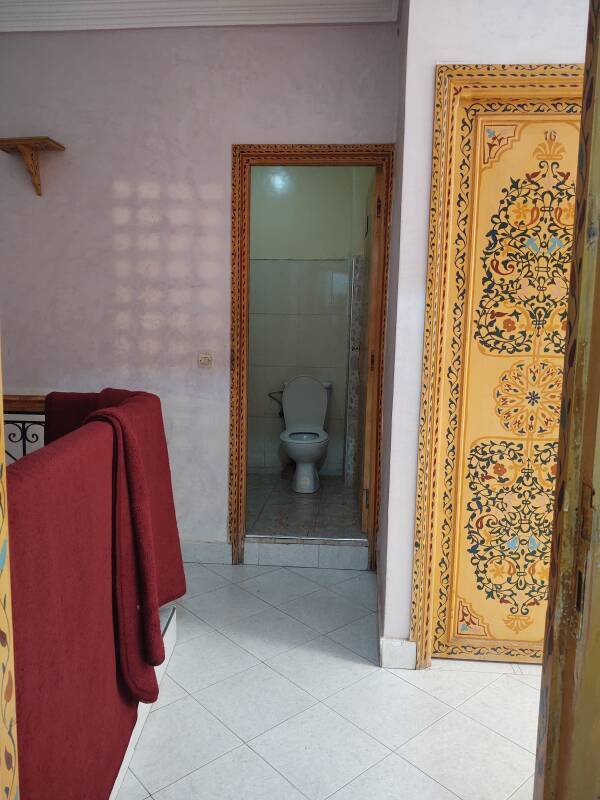
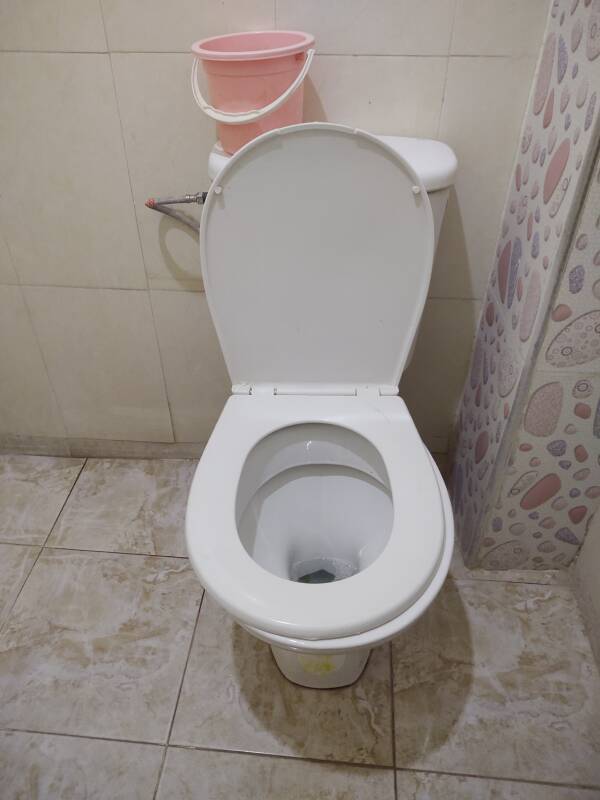
Where do I put used toilet paper? Wipe or Wash?
How do I clean myself, with paper or water?
There was no toilet paper in the bathroom, and the trash bin was across the room under the sink.
The shower had a hose with a nozzle but not what I expect in a shower head. That plus the lack of paper and remotely located trash bin, plus the bucket that was always sitting on the toilet tank or beside the toilet, told me that the establishment expected guests to clean themselves with water, not paper.
If you did elect to use your own facial tissue, then of course that should go into the trash bin and not into the toilet.
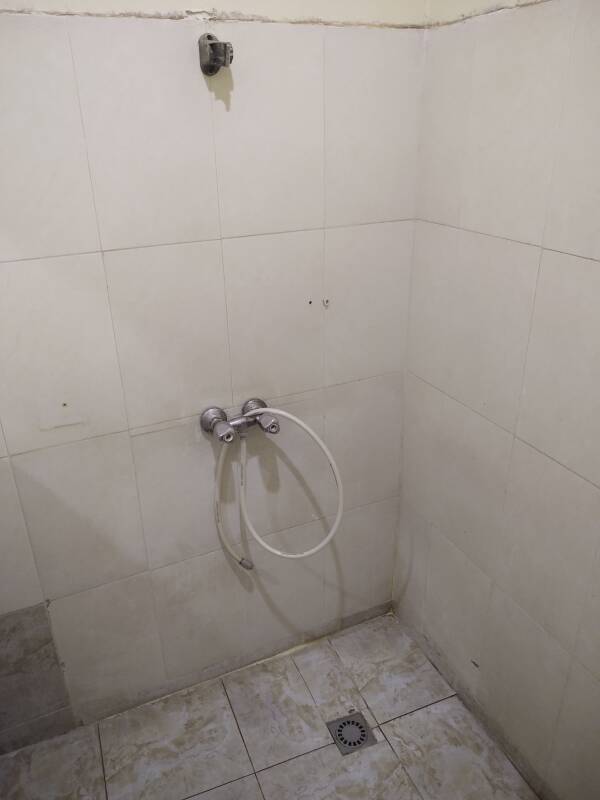
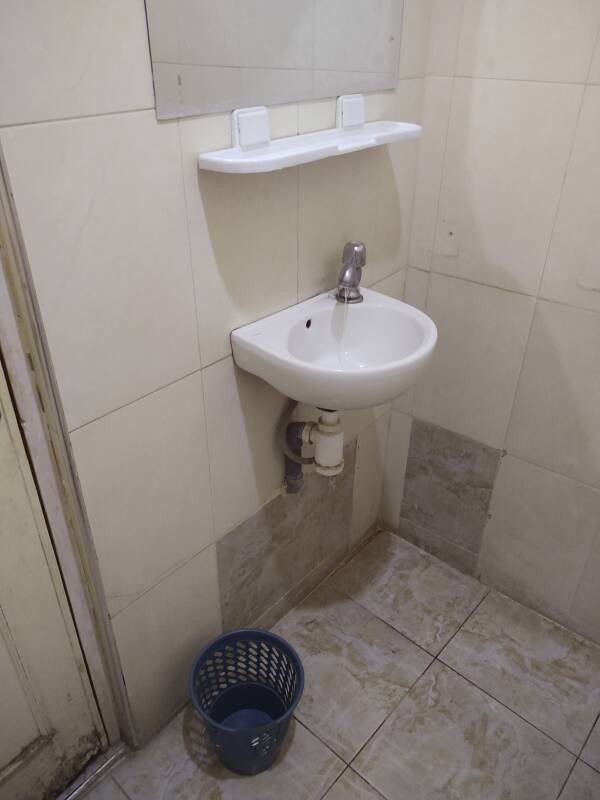
Hôtel Atlas
After a few days in Marrakech I continued southeast by bus into the desert, to Zagora and M'Hamid el Ghizlane. When I returned to Marrakech, I stayed at the Hôtel Atlas. It was very close to the Riad Zitoun Lakdim. I had set up both stays through Booking.com, uncertain of exactly what to expect at either one. Both were nice, but the Hôtel Atlas was the nicer of the two. And it was a little cheaper, at 105 Dirham or about US$ 10 per night.
Below is the view out the door of my room, looking across the central courtyard that's open to the sky. The shared bathroom was across the courtyard.
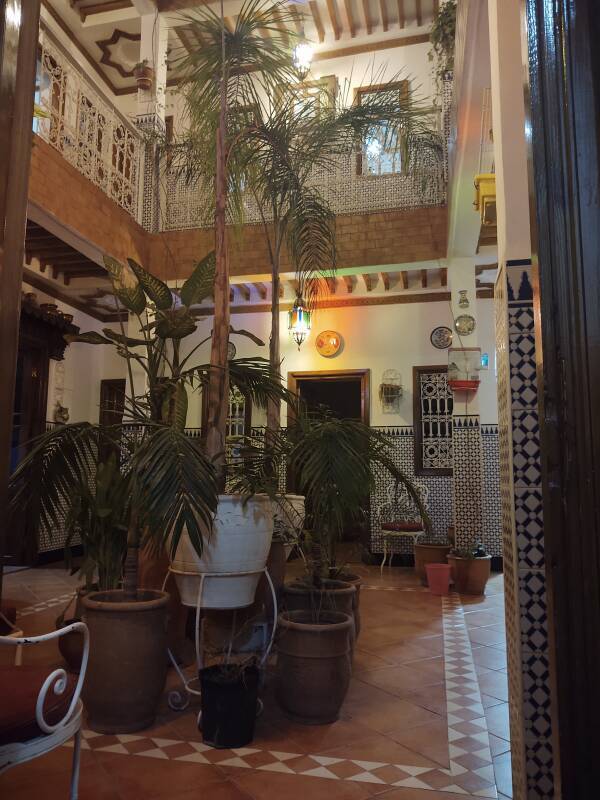
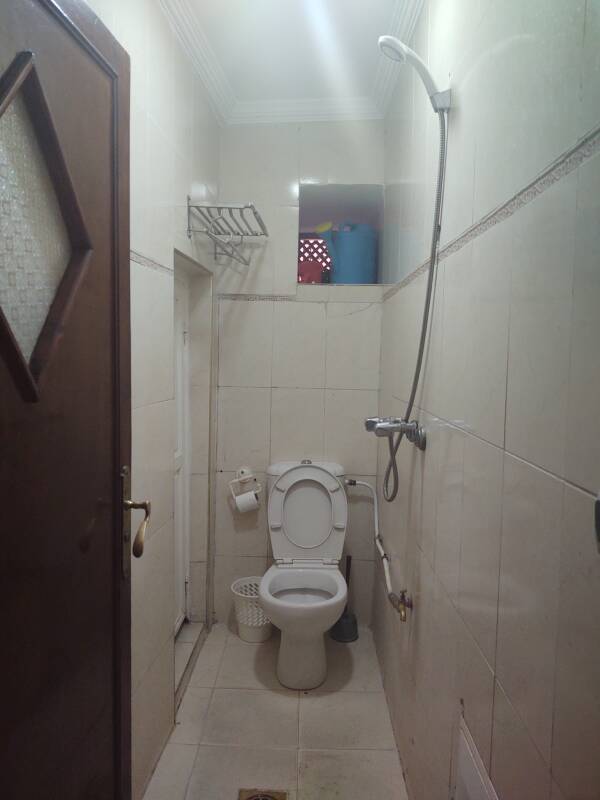
As you see above with the toilet paper and trash bin next to the toilet, along with the nearby spigot, they were prepared for both water and paper users.
Moroccan toilets seemed to generally be prepared for reasonable amounts of toilet paper. However, if there was a trash bin right there, then I put my used paper into it.
Where was the sink? Back in my room, between the window and door which both opened into the courtyard.
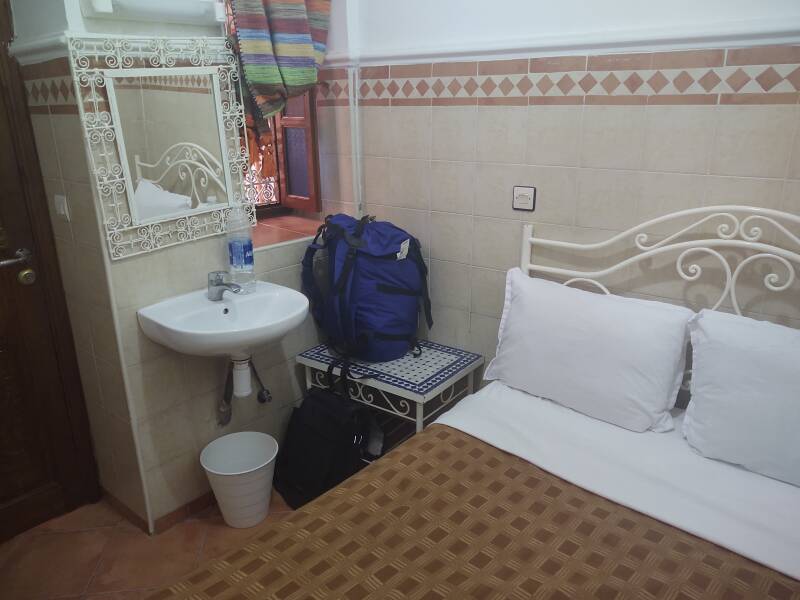
If the ground floor bathroom was busy, the next one was one floor up, directly above it. This one included a sink.
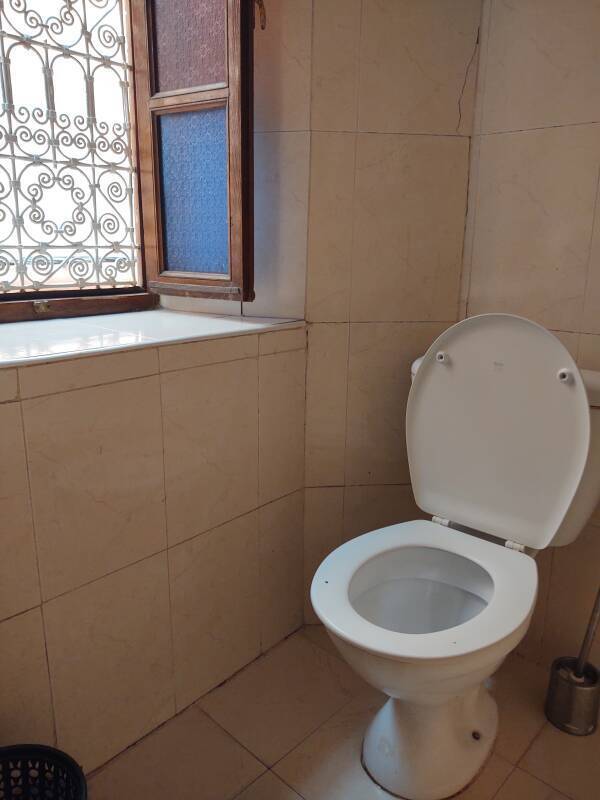
The window looked out the short distance across the lane to the facing building.
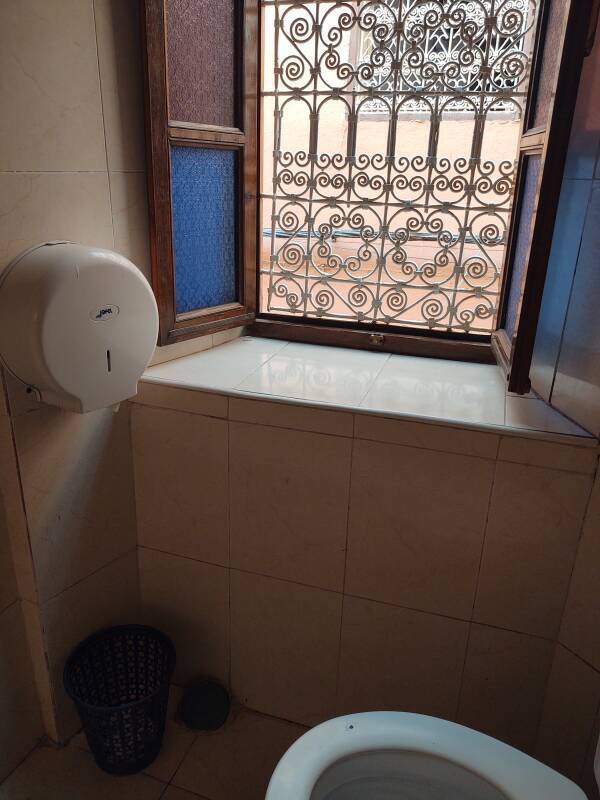
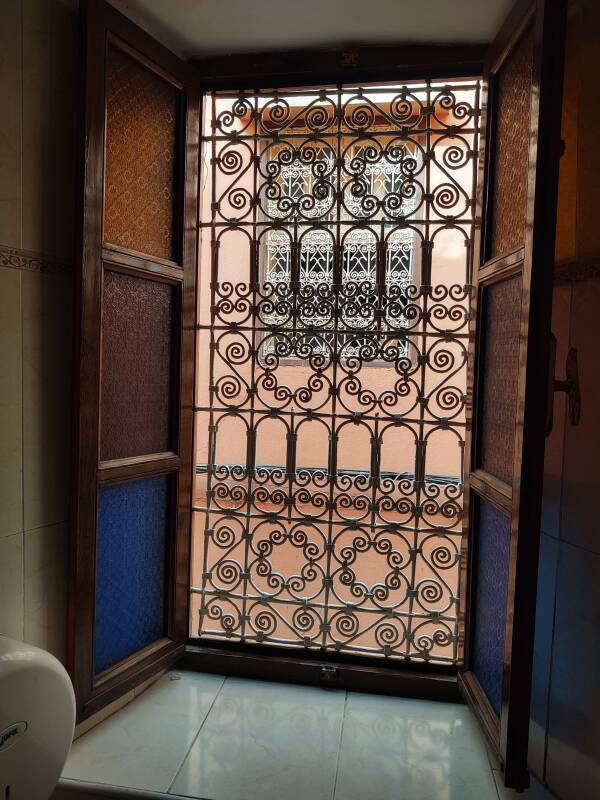
Mouassine Hammam and Fountains
Each neighborhood in a medina, the walled core of an old city, is based around the neighborhood mosque. And...
A mosque needs a mîdhâ, an ablutions facility, where worshipers can ritually clean themselves before praying. And...
The ablutionary water supply also feeds a fountain, providing water for drinking, cooking, and cleaning. And...
Some of the water is heated for a hammam, a public bath. And...
The fires that heat hammam water can also heat ovens where neighborhood residents' bread is baked. Residents and café owners prepare their dough and then puncture or cut it in personalized patterns so they can retrieve it after it has been baked in the community ovens.
So, the neighborhoods have fountains, baths, and bakeries. Some of the fountains are small and simple, others are large and ornate. The Mouassine fountain and hammam complex is one of the prominent ones in Marrakech. Its hammam was built in 1562, during the Saadian dynasty era.
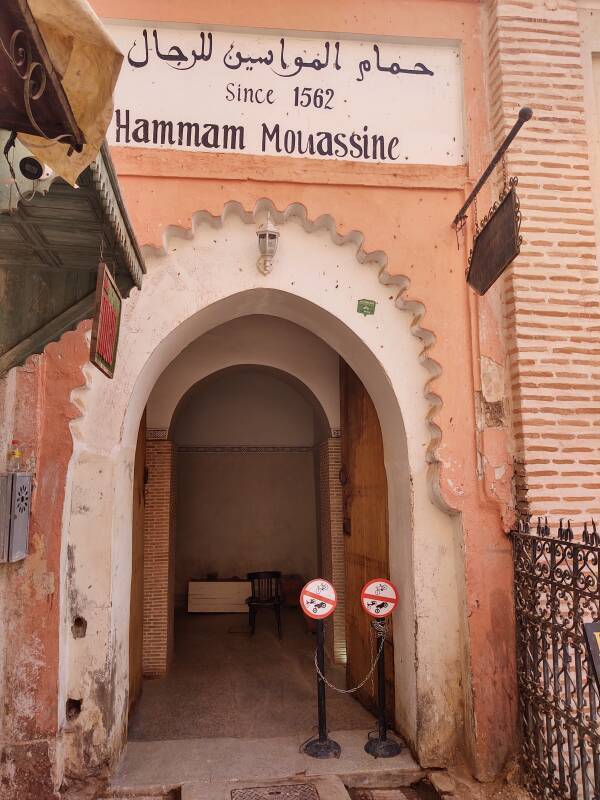
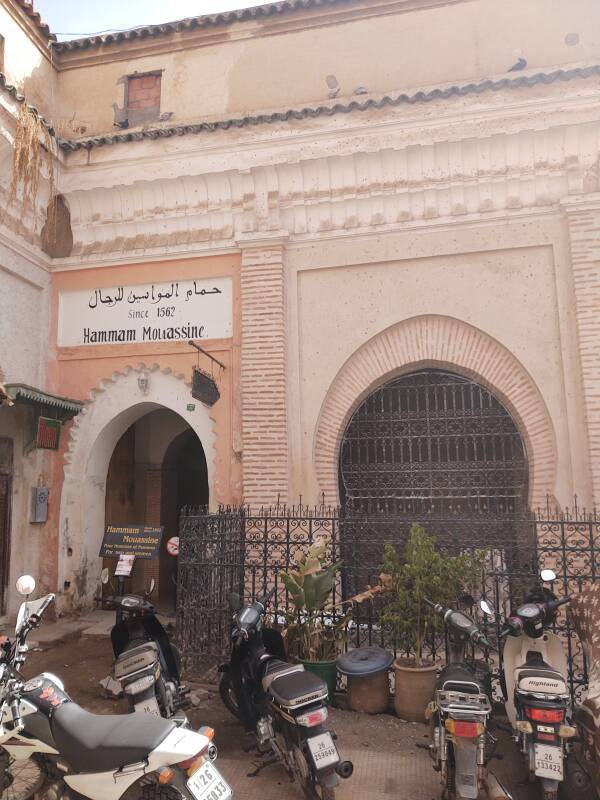
The Mouassine Mosque complex also includes a library, and it once included a children's Quranic school which is no longer in operation. The mosque's ablutions facility is adjacent to the hammam and the fountain.
I said, "O Messenger of Allah, my mother has died. Shall I give charity on her behalf?"
The Prophet said: "Yes."
I said, "Which charity is best?"
The Prophet said: "A drink of water."
— Ḥadīth reported by Sa'd ibn 'Ubadah
Zakat is a mandatory form of almsgiving. It's often considered to be a tax.
Sadaqah, on the other hand, is a voluntary act of charity, with sadaqah jariyah being an act of giving that keeps on giving.
Giving someone a glass of water is sadaqah, while setting up a fountain is sadaqah jariyah. A drinking trough for pack animals is sadaqah jariyah.
Allah's Messenger said, "A prostitute was forgiven by Allah, because, passing by a panting dog near a well and seeing that the dog was about to die of thirst, she took off her shoe, tied it to her scarf, and she used that to draw out some water for the dog. So, Allah forgave her because of that."
— Ḥadīth reported by Abu Huraira, Ṣaḥīḥ al-Bukhārī 3321.
The first three arched alcoves seen below contain troughs for drinking water for animals, especially the donkeys that were the main freight transport through the medina.
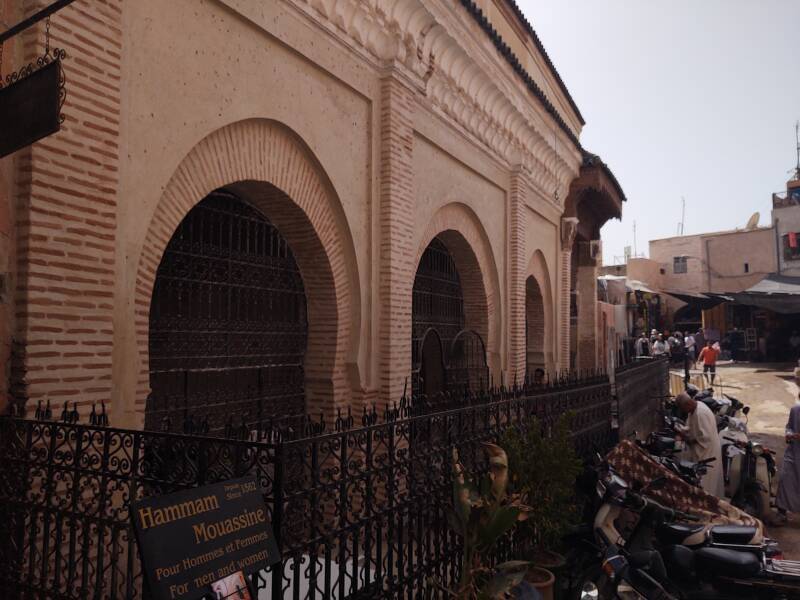
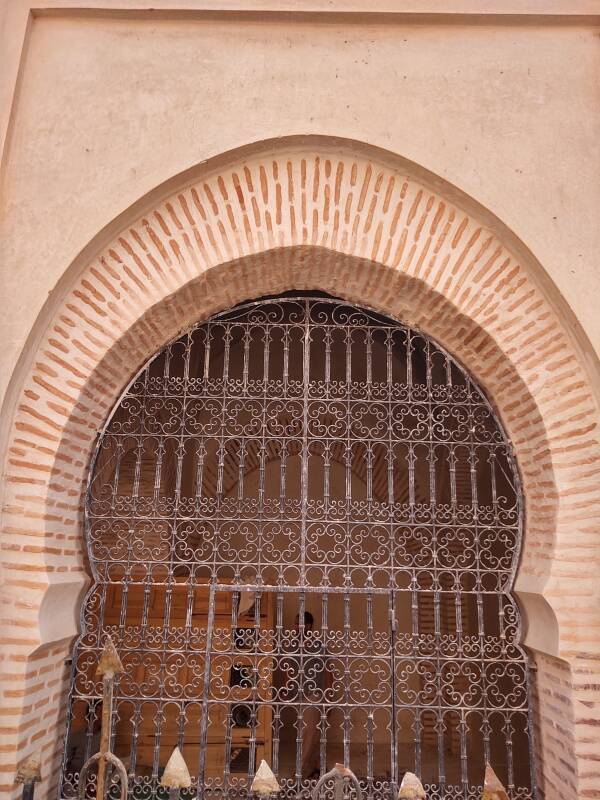
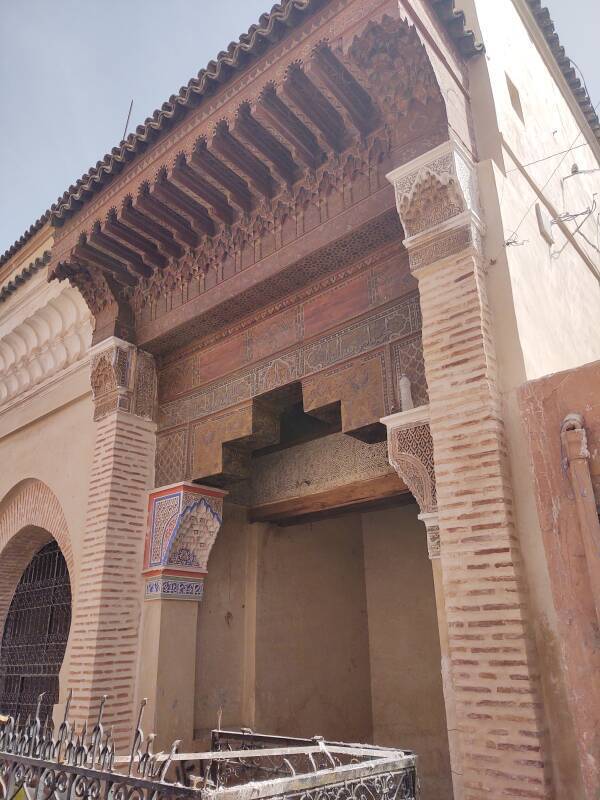
The fountain for people is at the far end.
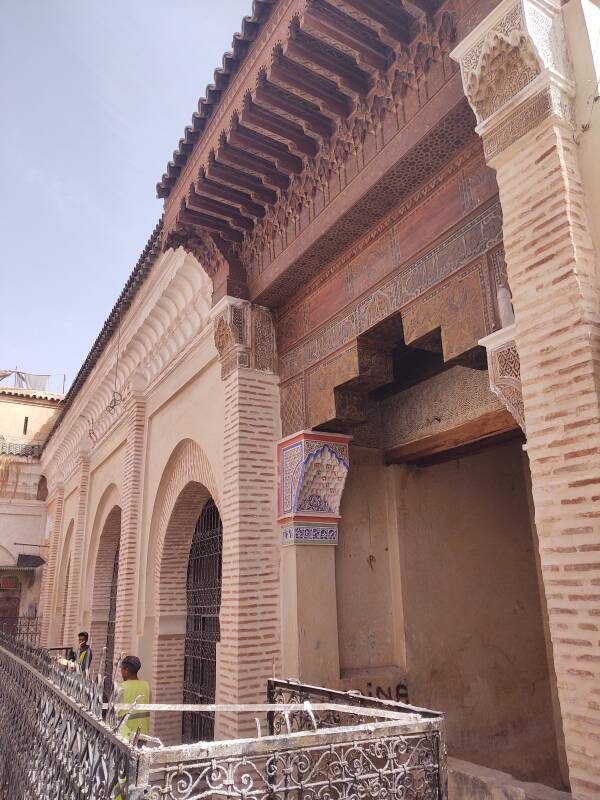
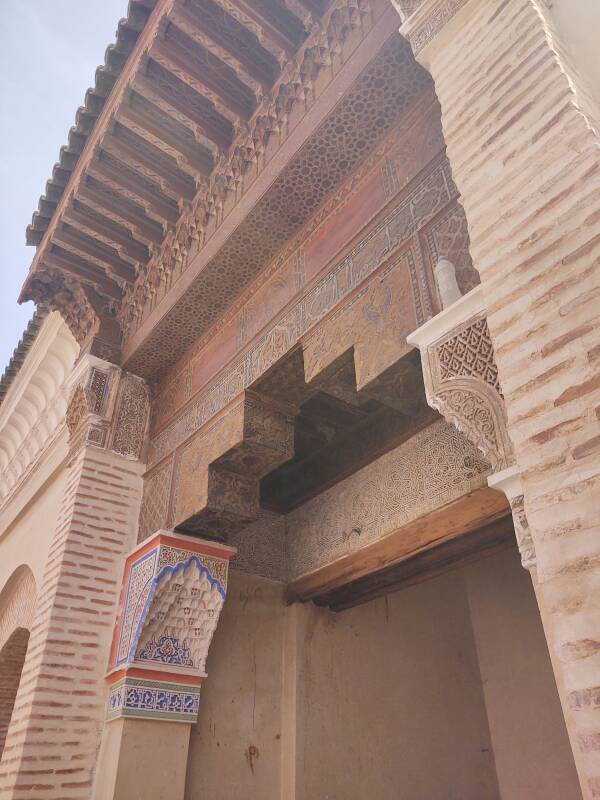
As with so many things in Morocco, the Mouassine fountain complex was being renovated during my visit.
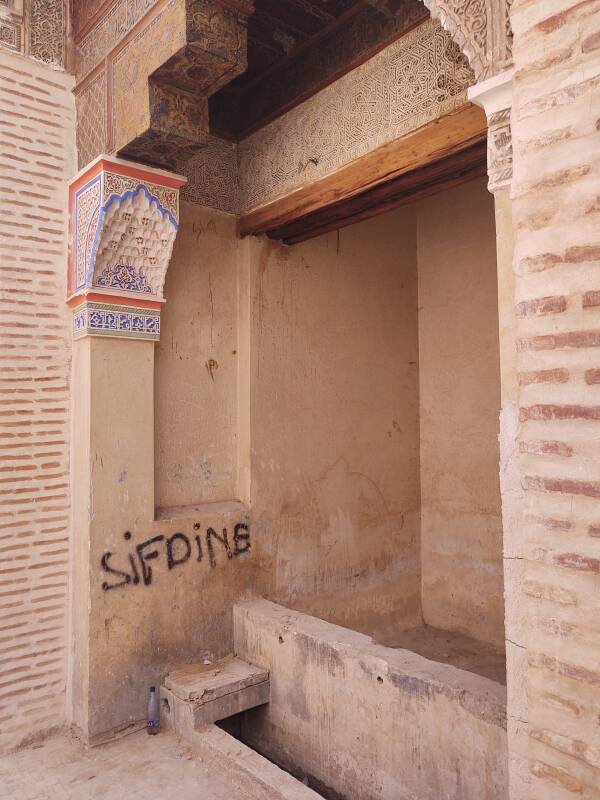
Here's how the fountain looked in a book published in 1904 — Things Seen in Morocco: Being a Bundle of Jottings, Notes, Impressions, Tales, and Tributes, by Alec John Dawson. Publishers just don't do subtitles the way they used to.
The Mouassine Fountain is rectangular with a corbel arch opening and a projecting canopy of carved cedar wood and tiles above that. Various devotional phrases were carved and painted onto the fountain.
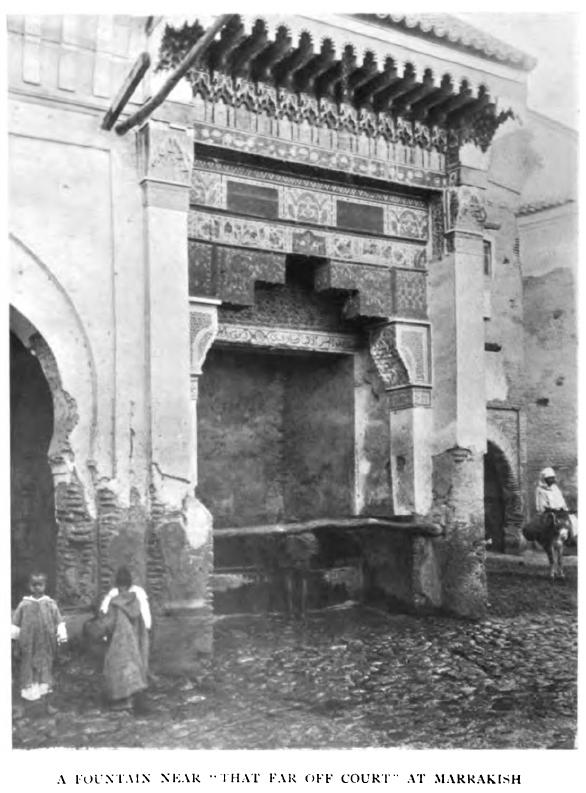
Picture from Things Seen in Morocco: Being a Bundle of Jottings, Notes, Impressions, Tales, and Tributes, Alec John Dawson, 1904.
Climate change has caused water tables to drop. Increasing population led to urban planning and new systems of water supply. The water supply systems established by the Almoravids in the 11th century CE were abandoned and the fountains were allowed to fall into disrepair. The ablutions room directly behind these fountains is still used, as they connected it to the new city supply.
Now, like the national highway system, the passenger rail lines, and so much else in Morocco, the fountains are being renovated.
Almoravid Waterworks in Marrakech
O you who have believed, when you rise to perform prayer, wash your faces and your forearms to the elbows and wipe over your heads and wash your feet to the ankles. And if you are in a state of janabah, then purify yourselves.
— Quran 5:6
The Almoravid Berber dynasty built an empire spanning today's Morocco, southern Spain, and beyond. The Almoravid chieftain Abu Bakr ibn Umar founded Marrakech around 1070 to serve as the imperial capital.
The Almoravid rulers never claimed the religious title of Caliph. Instead, they referred to themselves as Amir al-Muslimīn or "Prince of the Muslims" and formally accepted the religious authority of the Abbāsid dynasty Caliphs in Baghdad.
That was a cautious move by the Almoravids. Moulay Idress I, an earlier Moroccan leader, was apparently poisoned by an assassin sent from Baghdad in 791 by the Abbāsid Caliph Harun al-Rashid.
Things went well for the Almoravids, at least for a while. Their empire grew to include all of today's Morocco, extending significantly to the east and south, plus north across the Strait of Gibraltar to include more than the southern half of the Iberian peninsula.
The Almoravid emir Yusuf ibn Tashfin built the first mosque in Marrakech in the 1070s. His son and successor Ali ibn Yusuf (or Ben Youssef) completed a new central mosque between 1120 and 1132. It was the largest mosque ever built in the Almoravid empire, 120 by 80 meters in size with a minaret now estimated to have been 30 to 40 meters tall. Marrakech grew around this grand mosque, and it and the surrounding souqs formed the core of the city.
You exit the covered souq approaching the Ben Youssef complex on a lane known as Rue Azbezt. Here is the library, and the minaret of the mosque beyond it.
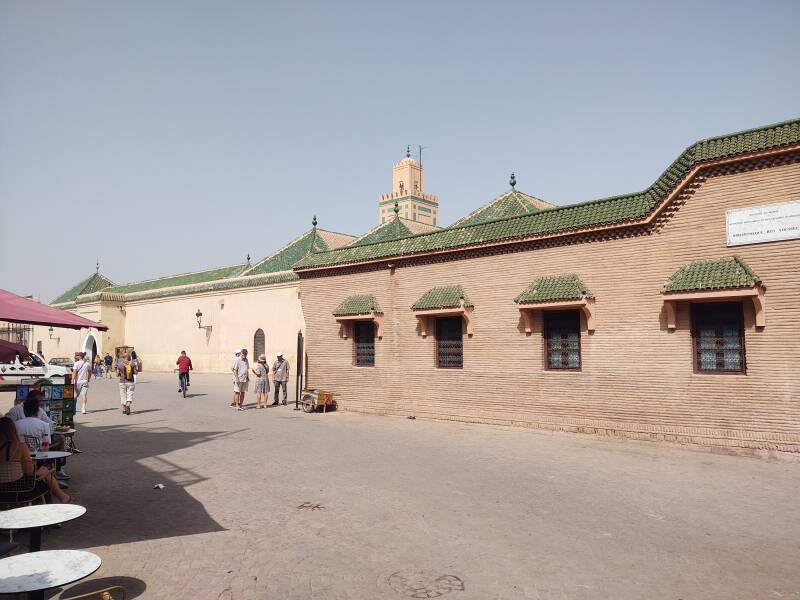
What you see today isn't Ali ibn Yusuf's original mosque. It's at least a replacement of a replacement.
The Almohads were another Berber tribe. This is confusing — Almoravids first, then the Almohads. Both Berber, but violently opposed to each other.
Tashfin ibn Ali was the sixth Almoravid Emir and the last successful one. He became besieged in 1145 while fighting the Almohads along the Mediterranean coast. He had burned his military encampment and was on his way to join an evacuation fleet and escape by sea when he fell off a cliff and died.
His son Ibrahim ibn Tashfin was an infant. He was proclaimed ruler as soon as news of his father's death reached Marrakech.
Baby Ibrahim's uncle Ishaq ibn Ali, brother of the father Tashfin ibn Ali, quickly replaced the infant Emir as the eighth and last Almoravid Emir. But just very briefly.
The Almohads captured Marrakech in April 1147. They immediately killed Baby Emir and Uncle Emir and began wiping out the Almoravid legacy in Marrakech. The Qubba el-Ba'adiyyin that we'll see further down this page is the only significant example of Almoravid architecture remaining in Marrakech.
The Almoravids were a Berber tribe from the desert. Other people called them al-mulathimun or "the veiled ones" because the men wore veils covering their faces below the eyes. The veil was practical for the blowing dust in the desert. The Almoravids insisted on wearing the veil everywhere, including throughout their new capital city, because it marked them as outsiders in the city. Everyone else was forbidden to wear this puritan garb, in order to make it clear who was the ruling class and also who was the most pious.
The Almohads were also a Berber tribe. However, they made a point of mocking the Almoravids' veil as a sign of effeminacy and decadence. The Almohads wore different misplaced desert garb, you see. Now that the Almohads were in power, they could wipe out all traces of the wrong tribe that wore the wrong clothes.
The Almohad caliph Abd al-Mu'min announced that the Almoravid mosque had an orientation error, its qibla or direction of prayer pointed the wrong direction. They either demolished the Almoravid mosque immediately, or abandoned it and allowed it to fall into ruin.
The Almohad empire grew until they controlled all of the Maghreb or northwest Africa to a point well east of Tripoli and slightly east of Sicily and Malta by the 1150s, and north through all of Muslim Iberia by 1172.
The Almohads built the Kutubiyya Mosque at the southwestern edge of the city to serve as the main congregational mosque. They also built the Kasbah Mosque for their new palace complex in the south.
However, the souqs of Marrakech were mostly around the old Almoravid mosque site, and so the area wasn't abandoned.
The Saadian dynasty took power in the 16th century and restored and extended this area of the city. The Saadian sultan Abdallah al-Ghalib, who ruled from 1557 to 1574, is said to have restored or rebuilt the Ben Youssef Mosque. However, historians have never found any remains of the Saadian mosque or the Almoravid mosque that it replaced.
The mosque that was here fell into ruin through the 17th and 18th centuries CE. The 'Alawi sultan Suleiman, who ruled from 1792 to 1822, completely rebuilt it. By the early 19th century the qibla, the proper direction of prayer, had drifted from due south toward the southeast, before finally becoming the local bearing toward the Ka'aba, the roughly cubical black stone structure in Mecca.
That requires spherical geometry, which was no problem for the Islamic world well before the qibla was redefined. The Greek astronomer and mathematician Autolycus of Pitane had written his book On the Rotating Sphere in the late fourth century BCE. Then the Islamic mathematician Ibn Mu'ādh al-Jayyānī (989–1079) wrote The Book of Unknown Arcs of a Sphere in the mid 11th century CE. It's the first known work on the modern form of spherical geometry, written while Europeans were struggling to do addition in Roman numerals.
In Marrakech, the modern qibla is 91°, almost due east. And so, the new mosque is in a different alignment, and there is little to no sign of the mosque structures that came before.
Today's mosque is still called the Ibn Yusuf or Ben Youssef Mosque.
The conquering Almohads had demolished the nearby Ben Youssef mosque after they captured Marrakech in 1147. This associated ablutions facility was abandoned. By the time the Saadians rebuilt the mosque in the 15th century, the qubba was largely forgotten.
Local ground level tends to rise as dirt and debris build up. By the beginning of the French Protectorate in 1912, it had risen by about six meters. The ruined qubba was almost entirely buried.
French archaeologists cleared away the rubble and accumulated soil and restored the qubba. Here is how it looked in 1954, just two years before the end of the Protectorate:
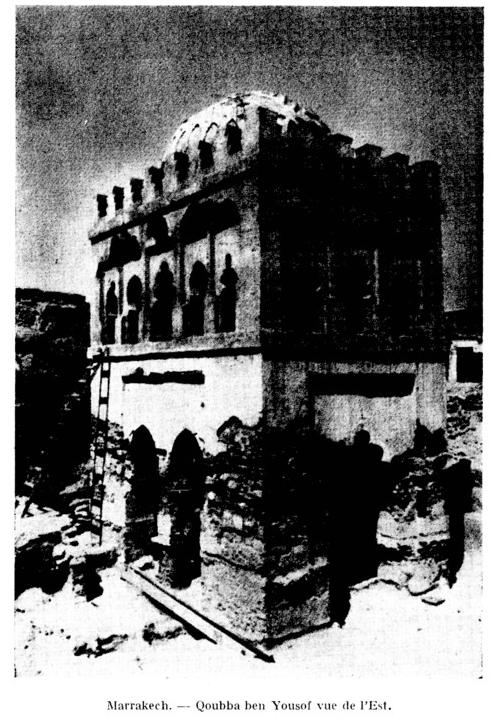
From " Une qubba almoravide a Marrakech", Jacques Meunié, Comptes rendus des séances de l'Académie des Inscriptions at Belles-Lettres, 1954, pp 226–233.
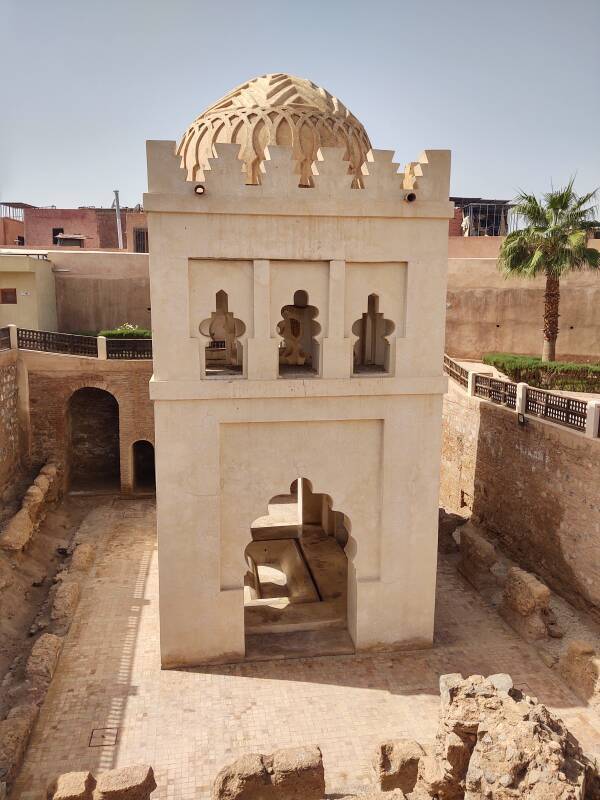
By the time I visited in 2022, the qubba had gone through two more significant restorations and appeared as you see above. The Moroccan Ministry of Culture and the Omar-Benjelloun foundation restored the qubba and the nearby Ben Youssef madresa in 1999. Then the Ministry of Culture carried out another restoration in 2019.
The recent restorations have the qubba looking like new. They have also cleared away debris covering associated water infrastructure that has been left in a more original state.
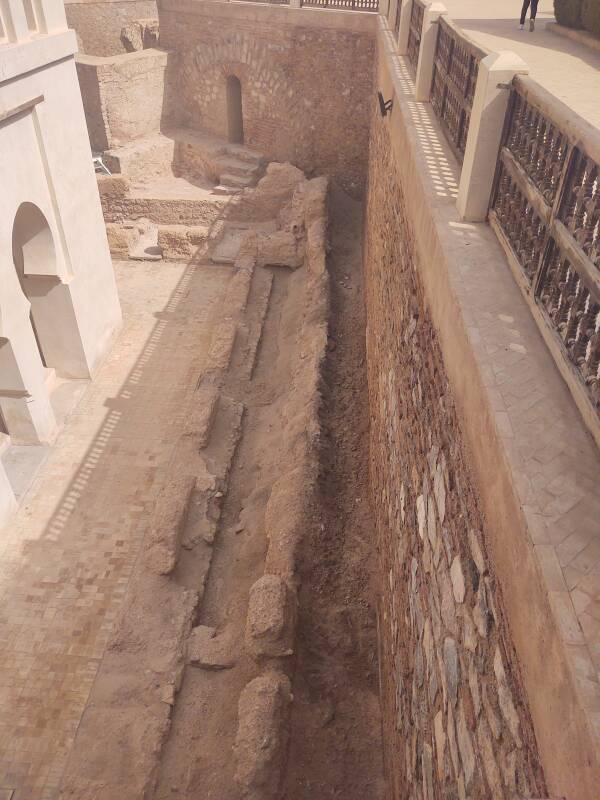
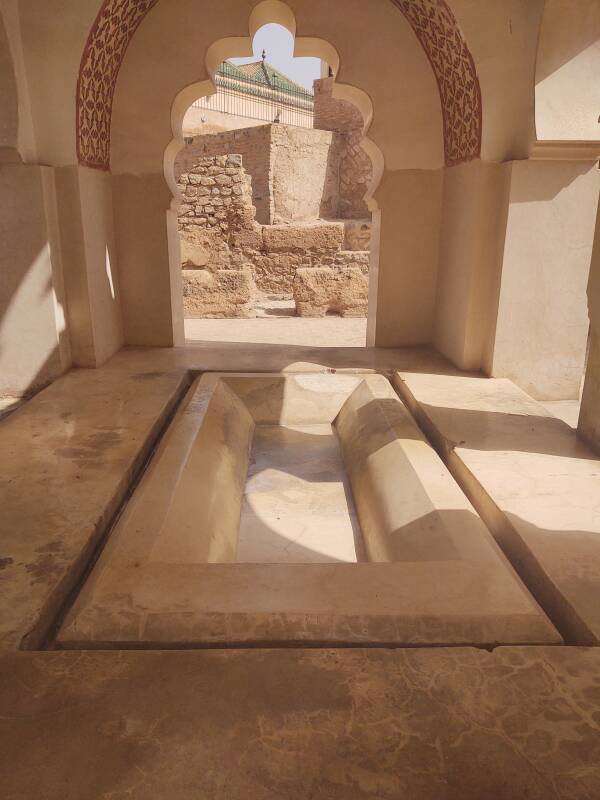
The large central ablutions basin is made from marble.
The water supply flushed waste from the latrines.
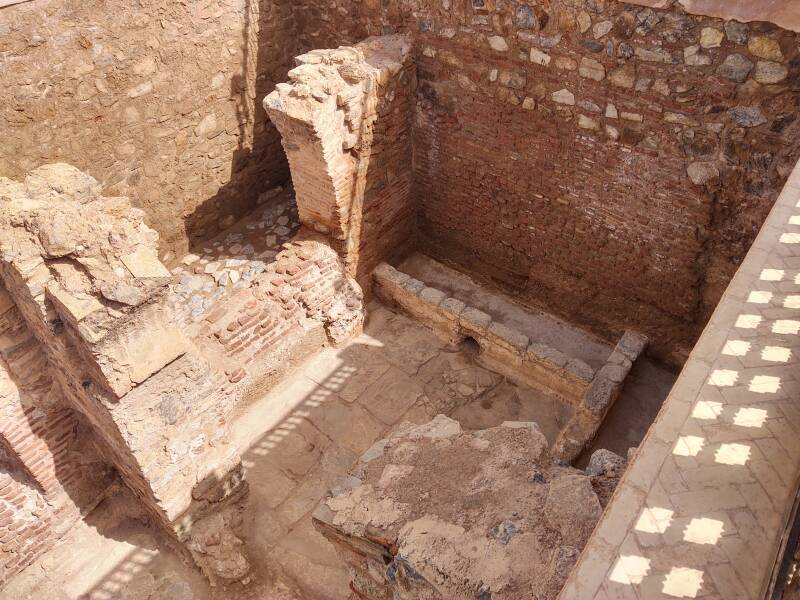
All of these ablutions basins, fountains of drinking water, and latrines required significant water supply surge capacity.
That was provided by a large cistern, which the traveler to toiletological sites can also visit.
This entire complex had been completely buried until the French archaeologists cleared away the accumulated debris.
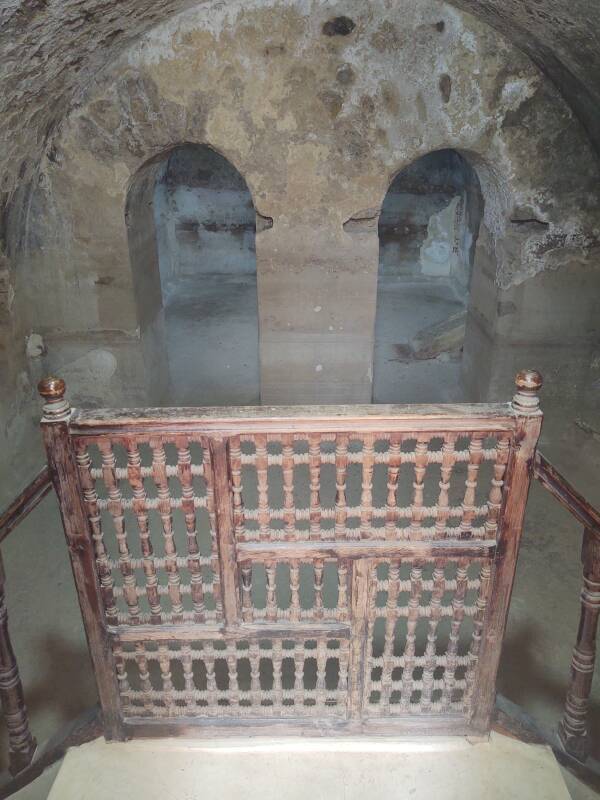
The cistern has two large chambers with arched roofs, connected by two arched doorways. It was supplied by a khettara system.
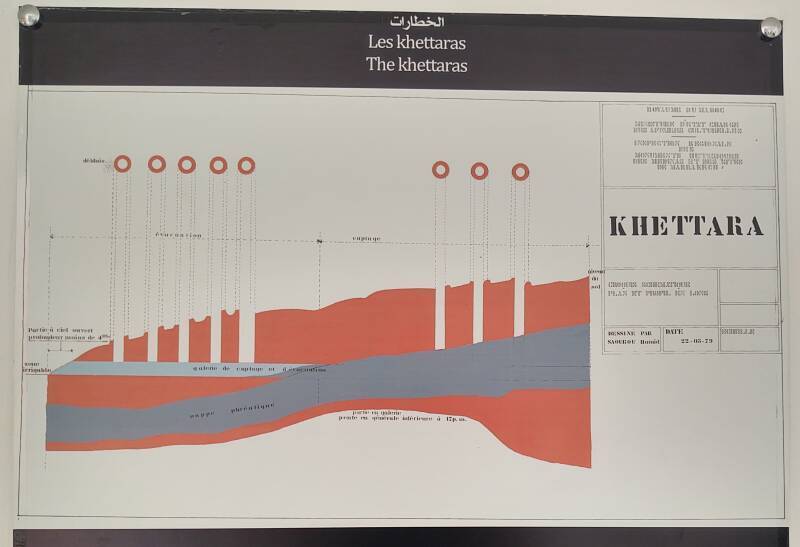
Qanat is one of the many Arabic words that Frank Herbert used for his Dune books, although he refers to it as "an open canal" rather than a proper qanat or khettara.
Well, maybe in the later books in the series, but not on the hyper-arid planet of Arrakis described in the original.
Ben Youssef Madrasa
The Ben Youssef religious complex within the medina of Marrakech includes what was once the largest Islamic school in Morocco.
The Marinid dynasty of 1244–1465 is known for its support of the arts and literature. They built several madrasa or schools across Morocco, including this one built during the 1331–1348 rule of Sultan Abu al-Hasan.
The Saadian ruler Abdallah al-Ghalib built a new madrasa in its place in 1563–1565, following the earlier Marinid architectural style.
The Ben Youssef Madrasa operated until 1960, when it was closed down. It was restored and opened to the public as a historical site in 1982.
The madrasa is large, occupying a space about 40×43 meters. However, you approach via a narrow lane between multi-story buildings and so, as usual, you approach through a small passageway with no idea of what is on either side.
You enter through a single plain door, go down a narrow corridor into a small vestibule, and step through a door into the central courtyard.
The design is intended to inspire revelation and astonishment as you step into the large intricately decorated space.
Galleries along two sides provide spaces for classes to gather.
Student dormitory rooms surround the courtyard on the ground level and on upper levels.
Zellij geometric tilework covers the walls up to about eye level. Then there are rows of painted and carved Arabic devotional text, and carved stucco and cedar wood above that.
In its time, this was the largest madrasa in Morocco. The 130 dormitory rooms housed up to 800 students. Most rooms would have been home to six students, with seven or more in some larger ones. The nicest ones had windows opening into the central courtyard and the fountain. The central fountain and the other ablutions facilities were supplied by the same khettara system that filled the cistern at the nearby qubba.
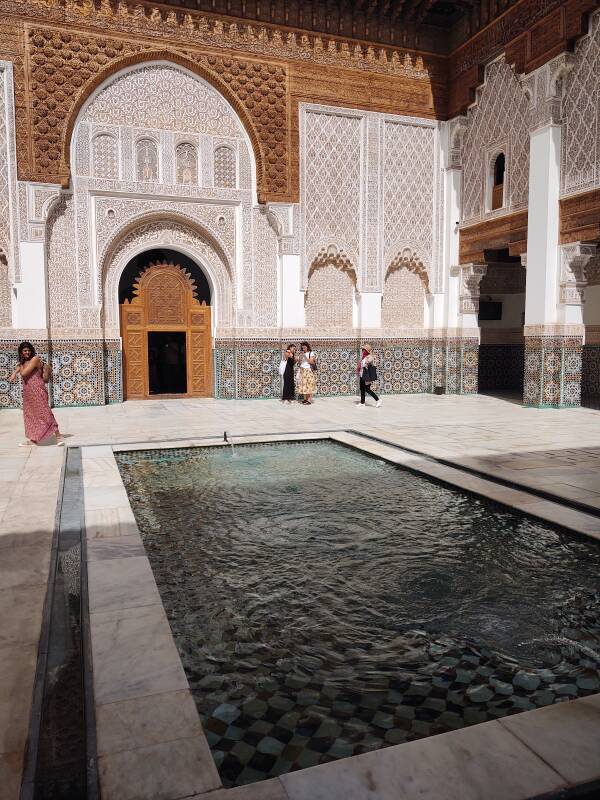
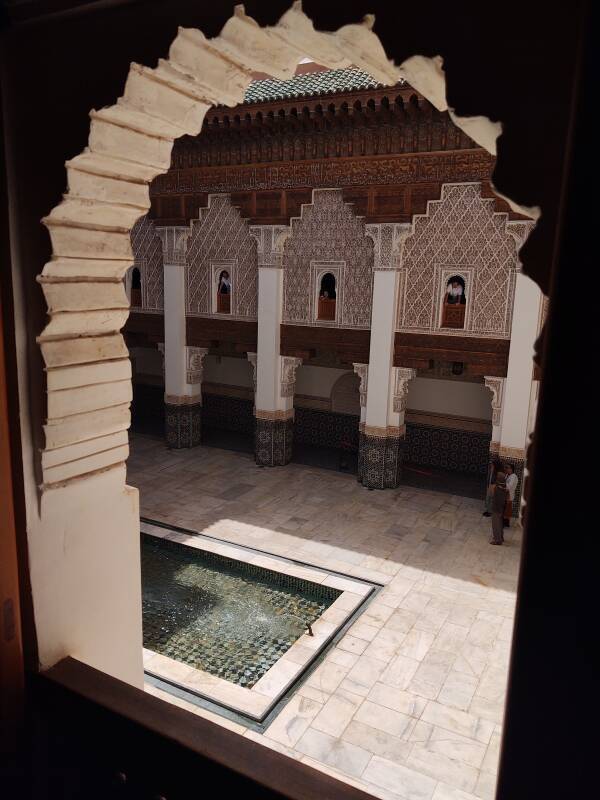
I stopped at a café on my way back through the medina. Seats on its rooftop looked out over the medina. A small door on the steep staircase provided access to the bathroom.
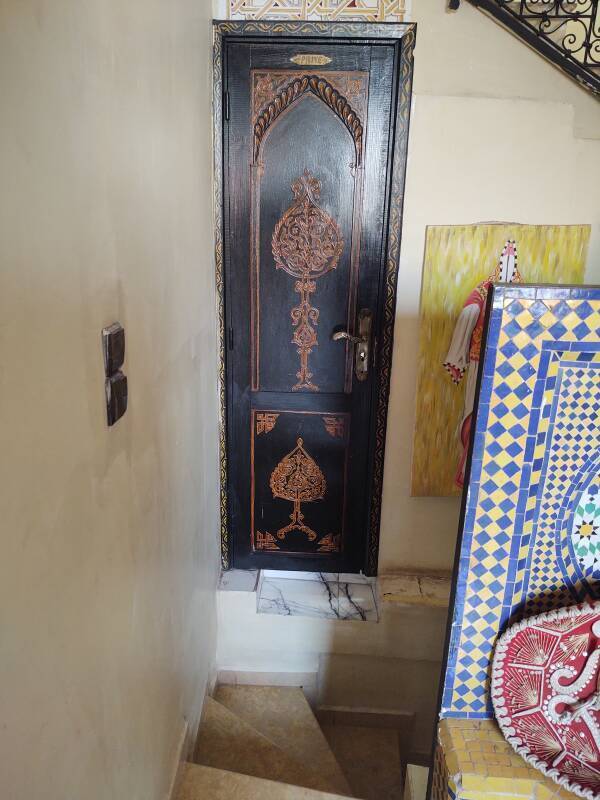
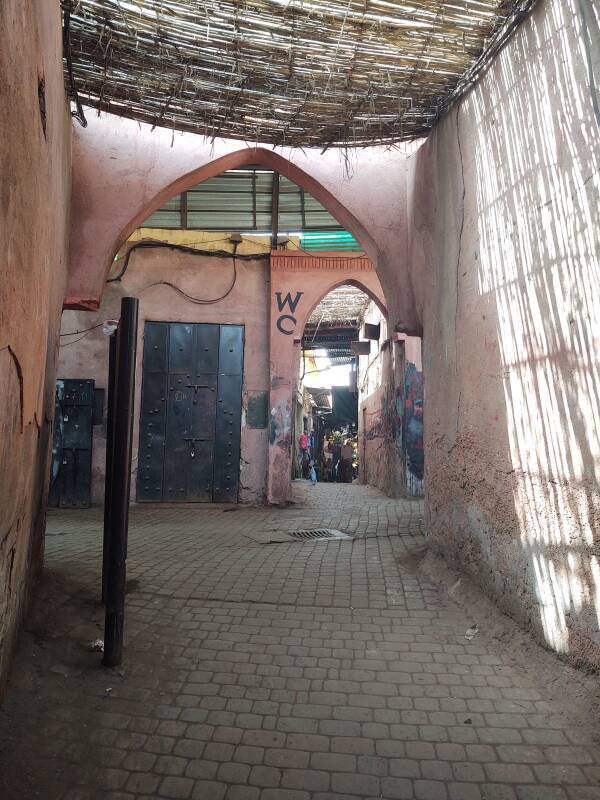
There are also public toilets in the medina, signs mark the way.
There's much more to see at Marrakech, see my general travel page.
If you're following the pages in the order I visited places during my trip, the next stop is the city of Zagora. Or, feel free to jump around:

